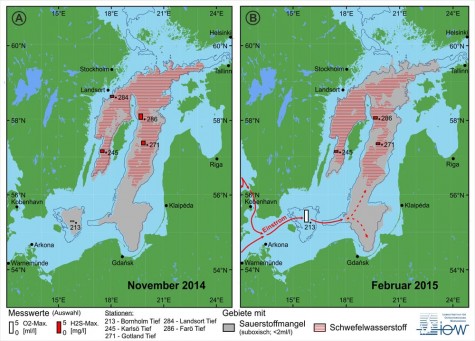Oxygen arrived at the bottom of the Central Baltic Sea

Comparative maps from areas with oxygen depletion and hydrogen sulfide occurrence in the near-bottom water layer of the Baltic Sea at the time of A- November 2014 (stagnation) an B-February 2015 (salt water inflow). At selected stations, oxygen and hydrogen sulfide concentrations are depicted in bar chart. The 70 m isobath serves for orientation and illustration of the deeper basins in the central Baltic. Source: IOW
The Eastern Gotland Basin in the centre of the Baltic Sea is the largest and second deepest of the Baltic Sea basins. Here, the water masses and any marine life below 90 m water depth nearly constantly suffer from oxygen depletion and toxic hydrogen sulfide.
For this reason, these regions are often referred to as “dead zone”. Physical Oceanographers from the Leibniz Institute for Baltic Sea Research in Rostock Warnemünde now measured oxygen in the bottom water. This proves their earlier presumptions that the amount of inflowing water masses was large enough and its salt content and density sufficient to let them pass the submarine sills and reach the Baltic Proper.
The inflow of December 2014 was the largest event since 1951 and the third largest since the beginning of oceanographic measurements in the Baltic.
The scientific crew with Dr. Lars Umlauf as chief scientist on board of r/v ALKOR is on its way through the central Baltic Sea from the 26th of February to 11th of March 2015.
Contact:
Dr. Michael Naumann, Department Physical Oceanography and Instrumentation, IOW (phone: +49 381 5197 267, Email: michael.naumann@io-warnemuende.de)
Dr. Barbara Hentzsch, Public Relation, IOW, phone: +49 381 5197 102, Email: barbara.hentzsch@io-warnemuende.de)
Background information: salt water inflows
The water body of the Baltic Sea is permanently stratified with brackish surface water fed by the constant freshwater discharge of numerous rivers. This surface layer is in constant exchange with the atmosphere. It is well provided with oxygen by wind mixing, temperature-induced convection processes and the biological production. From a depth of approximately 70 m on, in areas which are no longer influenced by wind mixing, the Baltic Sea shows its close connection to the North Sea: it is here that the salty North Sea water concentrates which periodically flows into the Baltic Sea via the Danish Belt Sea, Being saltier than the Baltic Sea water, it is also heavier, thus it is flowing along the bottom of the Baltic Sea into the deep basins.
Both water bodies do not mix but to a minor degree which causes a permanent stratification. Solid particles like dead organic matter can easily pass this boundary whereas gases dissolved in the water are hold back efficiently. The oxygen content of the deep water therefore constantly decreases as the oxygen is consumed during the decomposition of the deposited organic particles. When the oxygen is entirely depleted, toxic hydrogen sulfide forms. An improvement of this state can only be reached by the lateral supply with large amounts of North Sea water which has been in contact with the atmosphere and therefore is rich in oxygen.
Submarine sills in the Western Baltic Sea hamper this horizontal water exchange. Only under specific meteorological conditions, the salt water can pass these natural impediments to supply the eastern/central parts of the Baltic Sea with oxygen. These sills are the so called Darß Sill, an extended sandy plain between the Danish Island of Moen and the peninsula of Fischland-Darß-Zingst with water depths of 18 – 19 m, and the Drogden Sill being positioned in the Oere Sound between the Danish island Zealand and the Swedish mainland with water depths of only 8–9 m.
Since 2003, no major salt water inflow has occured, which has led to the fact that in the deep areas of the central Baltic Sea (>90 m) all oxygen has been consumed and an increased formation of hydrogen sulfide went on. Thus, the biological living conditions for higher organisms have strongly been limited in these areas, which therefore were often referred to as “dead zones” in the media .
The IOW is a member of the Leibniz Association to which 89 research institutes and scientific infrastructure facilities for research currently belong. The focus of the Leibniz Institutes ranges from Natural, Engineering and Environmental Science to Economic, Social, and Space Sciences and to the humanities. The institutes are jointly financed at the state and national levels. The Leibniz Institutes employ a total of 17.200 people, of whom 8.200 are scientists, of which 3.300 are junior scientists. The total budget of the Institutes is more than 1.5 billion Euros. Third-party funds amount to approximately € 330 million per year. www.leibniz-gemeinschaft.de
http://www.io-warnemuende.de/baltic-inflow-of-december-2014.html – More information on the inflow event of December 2014
http://www.io-warnemuende.de/baltic-inflow-of-december-2014-computer-simulation…. – Computer simulation showing the bottom-near distribution of the inflow water.
Media Contact
All latest news from the category: Earth Sciences
Earth Sciences (also referred to as Geosciences), which deals with basic issues surrounding our planet, plays a vital role in the area of energy and raw materials supply.
Earth Sciences comprises subjects such as geology, geography, geological informatics, paleontology, mineralogy, petrography, crystallography, geophysics, geodesy, glaciology, cartography, photogrammetry, meteorology and seismology, early-warning systems, earthquake research and polar research.
Newest articles

First-of-its-kind study uses remote sensing to monitor plastic debris in rivers and lakes
Remote sensing creates a cost-effective solution to monitoring plastic pollution. A first-of-its-kind study from researchers at the University of Minnesota Twin Cities shows how remote sensing can help monitor and…

Laser-based artificial neuron mimics nerve cell functions at lightning speed
With a processing speed a billion times faster than nature, chip-based laser neuron could help advance AI tasks such as pattern recognition and sequence prediction. Researchers have developed a laser-based…

Optimising the processing of plastic waste
Just one look in the yellow bin reveals a colourful jumble of different types of plastic. However, the purer and more uniform plastic waste is, the easier it is to…



